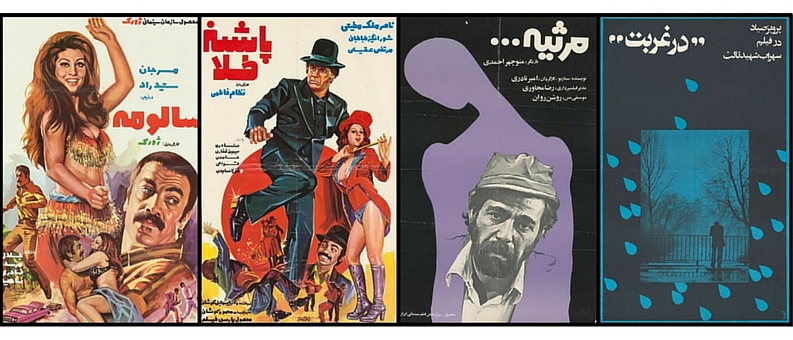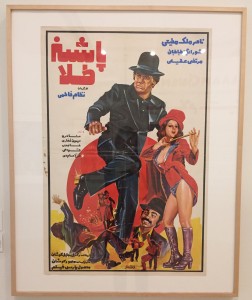All I knew about Tehran was that my mother lived there when was 17 years old. The year was 1972, only seven years before the Islamic Revolution would overthrow the 2,500 year long monarchy in Iran. Yet, as my mother is not one to tell stories of her youth, all I knew about this distant place and time was that my mother and her family had lived there. Thus, Tehran had always been cloaked in a kind of mystery for me. It seemed familiar and yet simultaneously unknown. As a result, whenever I heard the place mentioned I always perked up, hoping to find out more about this geographical and temporal location.
With this limited, but deeply curious, mindset, I approached the Block Museum’s exhibition Salaam Cinema! 50 Years of Iranian Movie Posters. The exhibit appears to have been created with the awareness of completely uninformed audience members like me. Drawing you from the door to the title wall, a thin black timeline stretches from 1900 to the present. The timeline weaves together the sociopolitical and film history of this timespan in Iran, marking out major moments in Iranian film and global politics. Under the bold calligraphic red exhibition title, the wall text, a staple of museum exhibitions, then articulates the focus of the exhibition: Iranian movie posters selected from Hamid Naficy’s Iranian Movie Poster Collection, recently acquired by the Northwestern University Archives. Foreshadowing the exhibit, the text informs the viewer that these posters give us access to both the aesthetic narratives and the social history of Iran from the 1960s to the present.
One such poster is entitled Golden Heel (Pashneh Tala); the poster was designed by Masud Behnam and the movie was directed by Nezam Fatemi in 1975. The film exemplifies a subset of filmfarsi cinema (Persian language urban genre movies), which dominated the Iranian cinema landscape before the 1979 Islamic revolution. Specifically, Golden Heel (Pashneh Tala) is a “tough-guy” film (filmha-ye jaheli). These movies “were known for their sharp dialogue, fast-moving plots, and flamboyant musical numbers.”[1] Roughly 40 years after it came out, this dynamism is still evident in the movie’s poster. Against an off-white background framed with a black line, dazzling colors—lipstick red, golden yellow, several hues of black, cobalt blue, glimpses of grey, and shades of brown—move the viewer’s eyes across the poster.
Near the center of the poster, a single golden heel glints in the light. The thick heel platforms a pair of black dress shoes worn by the archetypal “tough-guy” (lutis and jahels). Clad in a sharply collared black suit and felt hat, the man’s rugged face looks resolutely out into the distance. Frozen in action, the man lifts his right leg, giving the viewer a moment to glance the dazzling gold right before he is about to dash or fight. Below his foot, a man falls backward, suggesting that the tough-guy has just done some damage with this golden heel. As is typical of these characters, he looks perpetually ready to protect and defend his neighborhood.
The monumental man stands in the center of the poster, connecting the poster’s bottom edge to the writing at the top of the off-white background. Beside the tough-guy a scantily clad woman stands at about three-quarters of his height. Dressed in a patterned bikini-like bottom, heeled knee-high boots, a lipstick-red-colored circus jacket and a matching top hat, she holds a baton between her hands. Her pose is alluring, while she fingers the stick in her hands, her legs stand spread slightly apart with one knee slightly bent, which pushes her buttocks backward. From toe to head, her lustrous black boots lead up to her glossy legs, which in turn, lead up to her bright red coat, which splits apart at the chest to reveal large portions of her breasts. This juxtaposition of the suit-clad tough guy next to the barely-clad woman gives the viewer a glimpse at how tough-guy movies “reinforced conventional gender roles and drew from traditional storytelling and character conventions.”[2]
As I walk through the poster-laden space, I am struck by the manner in which these movie posters transport me to another time and place. It’s as if they are each their own time capsule, giving me a glimpse of what it was like in, say, 1975 Tehran. After all, as a voracious consumer of popular culture, if I were to leave a time capsule of my own I would likely include some reference to one of the many television shows or movies I love. I wonder, what would someone from another country think if they walked into a museum, decades from now, and saw the 30 Rock meme I have on my phone?
Of course, it would not tell them much about the political moment—there are no traces of the Dakota Access Pipeline protests or Donald Trump’s presidential campaign. But there is a strange intimacy embedded in the consumption of popular culture. Amongst other things, the meme would tell them about the images that mediated contemporary social interactions, the visual rhetoric of the early 21st century, and the ways in which people interacted with visual culture. Wrapped into a larger exhibition and clarified with wall texts, it would offer an accessible point of contact between their time and ours.
I see much of this in the Block’s exhibition. The movie posters serve as friendly, pop-culture ambassadors, introducing uninformed viewers like me to a foreign place. Golden Heel (Pashneh Tala) does not tell me that in 1975 tensions were rising in Iran, the very tensions that would lead to the Islamic Revolution in a few years. Yet, the brightly colored poster does offer a glimpse into the visual culture of that time.
The originally hand-painted posters add dimension to this place and time far from my own. Golden Heel (Pashneh Tala) translates, for instance, information regarding gender dynamics, popular fashions, values, and narratives that captured a certain cultural imagination into a visual language accessible to even the most internationally-illerate viewer. Through a common practice of consuming mass culture, the poster offers a point of contact. I cannot read the writing on the poster, nor ascertain what the signs signified in their contemporary moment. Nevertheless, standing before the affable poster, I am connected to a broader quotidian consumption of popular culture, which, in turn, grants me access to a sense of the everyday life in a different time and place. I think that the exhibition and our increasingly divisive political time asks, nay, demands for such encounters with and meetings of unknown locations.
—
*All background information about the posters, Iranian political history, and exhibition come from the Block Museum’s wall text in the exhibition Salaam Cinema! 50 Years of Iranian Movie Posters.
[1] Wall Text, Salaam Cinema! 50 Years of Iranian Movie Posters, Block Museum, Evanston, IL.
[2] Wall Text, Salaam Cinema! 50 Years of Iranian Movie Posters.



831 Comments
I have express a few of the articles on your website now, and I really like your style of blogging. I added it to my favorite’s blog site list and will be checking back soon… Zonnepanelen Leuven
I really enjoy reading and also appreciate your work. Zonnepanelen Halle
It’s late finding this act. At least, it’s a thing to be familiar with that there are such events exist. I agree with your Blog and I will be back to inspect it more in the future so please keep up your act. Zonnepanelen Antwerpen
They’re produced by the very best degree developers who will be distinguished for your polo dress creating. You’ll find polo Ron Lauren inside exclusive array which include particular classes for men, women. Zonnepanelen Herent
This is a fantastic website , thanks for sharing. Zonnepanelen Antwerpen
You might comment on the order system of the blog. You should chat it’s splendid. Your blog audit would swell up your visitors. I was very pleased to find this site.I wanted to thank you for this great read!! Zonnepanelen Hoegaarden
Really impressed! Everything is very open and very clear clarification of issues. It contains truly facts. Your website is very valuable. Thanks for sharing. Zonnepanelen Antwerpen
Always so interesting to visit your site.What a great info, thank you for sharing. this will help me so much in my learning Zonnepanelen Huldenberg
We are really grateful for your blog post. You will find a lot of approaches after visiting your post. Great work Gevelbekleding
Thanks for the nice blog. It was very useful for me. I’m happy I found this blog. Thank you for sharing with us,I too always learn something new from your post. Zonnepanelen Kampenhout
I am genuinely thankful to the holder of this web page who has shared this wonderful paragraph at at this place Crepi
Great info! I recently came across your blog and have been reading along. I thought I would leave my first comment. I don’t know what to say except that I have. Zonnepanelen Kapelle-op-den-Bos